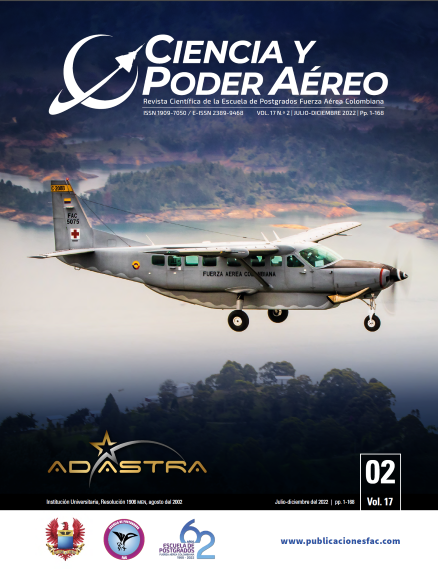Ecuadorian Air Force: on the way to multidomain. A transdisciplinary analysis in complexity
DOI:
https://doi.org/10.18667/cienciaypoderaereo.755Keywords:
hybrid threats, emerging threats, interoperability, interagency, cooperativeAbstract
Reflections on security, during the last decade, have mutated considerably and in a multiscalar way (global, regional, local); and, the concept of security, in terms of its analytical category, has evolved from state-centric dogmatic epistemic and methodological positions to more open and comprehensive ones, which has legitimized a sociocentric view of critical security studies. Thus, the traditional conceptions of the strictly military threat give way to other dimensions, and many States justify the assignment of extra-constitutional tasks to the Armed Forces, without Ecuador being an exception. Based on this, this academic article proposes, from a qualitative methodological design rooted in a transdisciplinary proposal in complexity, to build the interoperational guideline that will serve as a basis for the Ecuadorian Air Force (fae) to advance on its path towards the fulfillment of operations. multidomain. For its development, first, a transdisciplinary situational analysis of the Ecuadorian Air Force was built; As a next step, the megatrends projected for 2040 were defined, focused on the evolution of hybrid threats with axes in geopolitics and war, society and the digital environment; and finally, a doctrinal approach to multidomain was elaborated; The purpose concludes with a narrative where the redesign of the Nettis diagram is exposed, with which planners and decision makers will be able to analyze the threat multidimensionally and multiangularly, with which effective and comprehensive strategies and tactics can be developed, especially to face hybrid threats. and emerging whose complexity and success lies in the use of existing operational gray areas in the State.
Downloads
References
Álvarez, C. y Zambrano, J. (Abril, 2018). Globalización desviada: plataforma de convergencia criminal. Desafíos y Nuevos Escenarios de la Seguridad Multidimensional en el Contexto Nacional, Regional y Hemisférico en el Decenio 2015-2025. https://doi.org/10.25062/9789585652835.04
Bauman, Z. (2000). Modernidad líquida. Fondo de Cultura Económica.
Bartolomé, M. (2019). Amenazas y conflictos híbridos: características distintivas, evolución en el tiempo y manifestaciones preponderantes. URVIO. Revista Latinoamericana de Estudios de Seguridad, 4299(25), 8-23. https://doi.org/10.17141/urvio.25.2019.4249
Booth, K. (2005). Critical Security Studies and World Politics.
Constitución de la República del Ecuador. (2008). Registro Oficial N.° 449, 20 de octubre.
Comando Conjunto de las Fuerzas Armadas. (2020). Manual militar de planificación estratégica de las FF. AA. (1.a ed.).
Der Derian, J. (1990). The (S)pace of International Relations: Simulation, Surveillance, and Speed. International Studies Quarterly, 34(3), 295-310.
Fuerza Aérea Colombiana. (2019). Estrategia para el desarrollo aéreo y espacial de la Fuerza Aérea Colombiana - 2042. Fuerza Aérea Colombiana, 53(9), 1689-1699. https://d2r89ls1uje5rg.cloudfront.net/sites/default/files/estrategia_para_el_desarrollo_aereo_y_espacial_fuerza_aerea_colombiana_2042.pdf
Futures Platform. (2021). Plataforma de futuros. Plataforma de prospectiva colaborativa para tomadores de decisiones. https://www.futuresplatform.com/
Godet, M. (2003). La caja de herramientas de la prospectiva estratégica (4.a ed.). Centro Lindavista.
Grupo de Desarrollo Regional del Tecnológico de Monterrey. (2009). Las megatendencias sociales actuales y su impacto en la identificación de oportunidades estratégicas de negocios (1.a ed.). Instituto Tecnológico y de Estudios Superiores de Monterrey. https://portaldoc.itesm.mx/pls/portaldoc/docs/PORA3_1_20012012143549.pdf
Iturraga, S. (2020). Las operaciones multidominio para el US Army. Centro de Estudios Estratégicos de la Académia de Guerra de Chile, 23, 7. https://www.ceeag.cl/wp-content/uploads/2020/11/Estudio-CEEEAG-N°-23.pdf
Kellner, D. (1999). Virilio, War, and Technology: Some Critical Reflections. https://pages.gseis.ucla.edu/faculty/kellner/essays/viriliowartechnology.pdf
Max, M. (2005). Fundamentos de la transdisciplinaridad. Ecological Economics, 53, 5-16.
Mills, D. (2010). Coalition Interoperability: An International Adventure. Air University. https://www.airuniversity.af.edu/Portals/10/ASPJ/journals/Chronicles/mills.pdf
Ministerio de Defensa Nacional. (2018). Política de la Defensa Nacional del Ecuador.
Mojica, F. (2006). Concepto y aplicación de la prospectiva estratégica. Revista Med., 14(1), 122-131.
Moreno, Z., Villasmil, M., Duran, S., Parra, M. y Hernández, B. (2017). Importancia del pensamiento estratégico y acciones estratégicas para impulsar el emprendimiento social en las universidades venezolanas. Espacios, 38(45), 4. https://www.revistaespacios.com/a17v38n45/a17v38n45p04.pdf
Naser, A. (2021). Gobernanza digital e interoperabilidad gubernamental. Una guía para su implementación. Comisión Económica para América Latina y el Caribe (Cepal). Documentos de Proyectos (LC/TS.2021/80). https://repositorio.cepal.org/bitstream/handle/11362/47018/1/S2100258_es.pdf
Nettis, K. (2020). Multi-Domain Operations: Bridging the Gaps for Dominance. Sixteenth Air Force (Air Forces Cyber), 1-16. https://www.16af.af.mil/News/Article/2112873/multi-domain-operations-bridging-the-gaps-for-dominance/
Rubio, M. A. (2016). La transdisciplina en la investigación del diseño. Universidad de Guanajuato. https://bit.ly/33Z5pC4
United States Air Force. (2015). Future Operating Concept - A view of the Air Force in 2035. USAF. https://bit.ly/3larKmx
US Army. (Octubre, 2017). Multi-Domain Battle: Evolution of Combined Arms for the 21st Century (2025-2040). TRADOC, 79. https://www.tradoc.army.mil/wp-content/uploads/2020/10/MDB_Evolutionfor21st.pdf
Van Den Bosch, K. & Bronkhorst, A. (June, 2018). Human-AI Cooperation to Benefit Military Decision Making. Nato Science & Technology Organization, 1-12. https://www.sto.nato.int/Pages/default.aspx
Villalobos, A. V. (2003). Acepción ampliada de la interoperatividad. Revista de Marina, 26. https://revistamarina.cl/revistas/2003/1/Vergara.pdf1
World Economic Forum. (2022a). Quantum Computing. https://www.weforum.org/communities/gfc-on-quantum-computing
World Economic Forum. (2022b). The Metaverse. https://www.weforum.org/topics/the-metaverse
Downloads
Published
Issue
Section
License
Copyright (c) 2022 Escuela de Postgrados de la Fuerza Aérea Colombiana

This work is licensed under a Creative Commons Attribution 4.0 International License.
Assignment of Copyrights
Authors assign Ciencia y Poder Aéreo journal the exclusive rights (reproduction, distribution, public communication, and transformation) to exploit and commercialize their work, in whole or in part, in all the formats and modalities of present or future exploitation, in all languages, throughout the life of the work and throughout the world.
All contents published in Ciencia y Poder Aéreo journal are licensed under a Creative Commons Attribution 4.0 International License, whose complete information is available at http://creativecommons.org/licenses/by/4.0/
Under the terms of this license, users are free to download, print, extract, archive, distribute and publicly communicate the content of articles, provided that proper credit is granted to authors and Ciencia y Poder Aéreo, scientific journal of the Graduate School of the Colombian Air Force. Except when otherwise indicated, this site and its contents are licensed under a Creative Commons Attribution 4.0 International License.
For other uses not considered under this license it is required to contact the Director or the Editor of the journal at the e-mail address cienciaypoderaereo1@gmail.com.
The Graduate School of the Colombian Air Force and this publication are not responsible for the concepts expressed in the articles, including the metadata or the affiliation stated by authors. This is the full responsibility of the authors.






















